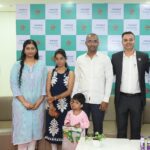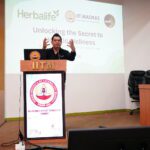New Delhi, April 1, 2017 : With her bundle of joy, a tiny baby girl in her lap, Sunita Sandra’s happiness was writ large on her beaming face. The baby girl was born in Bijapur district hospital just two days back. Sunita had earlier gone through the pain of two miscarriages.
Earlier pregnancy cases with complications had to be referred to Jagdalpur hospital, 170 kms away from Bijapur as there were no facilities for handling them because of lack of both medical expertise and equipment. Many a times, it would result in the death of the unborn baby or the mother.
The district hospital till 2015 worked with a skeletal staff of just 3 to 4 doctors and half a dozen nurses and the OT too was ill equipped to handle major surgeries.
Budhiram recalls the ordeal he had go through some years back when his Chacha Paternal uncle had broken his foot. “The only mode of transport available to bring him to Bijapur district hospital from his village 30 kms away was a bullock cart. The hospital could not handle this case and we had no option but to hire a vehicle for Rs 3500 to take him to the hospital in Jagdalpur. A marginal farmer, Budhiram had to borrow money from his relatives to pay for the hiring of the vehicle.
This time when he came to the hospital earlier this month to get treatment for his ailing mother, he could not believe the transformation the hospital had undergone. The hospital today has the latest facilities that many big cities may want to have and more importantly the infrastructure is backed by near full strength of doctors and specialists and other staff . The hospital has a new 50 bedded Mother and child Care unit ‘Umang’ and a 12 bedded Special Care New-born Unit (SNCU) to handle critical new born babies in addition to other medical facilities.
This has been possible thanks to some out of box thinking, political will, support from National Health mission in terms of funds and policies and UNICEF which facilitated implementation of various innovative strategies to reach out to the vulnerable and the marginalized in the district through its partnership with Public Health Foundation of India and EKAM. National Mineral Development funds in addition to other resources were also utilized for improving the health infrastructure for constructing both the hospital and residential facilities for the doctors.
The Collector of Bijapur district Dr. Ayyaj Tamboli, himself an MBBS even used social media to attract doctors to this remote district and the response was overwhelming.
Dr Kushal Madhukar Sakure from Bhandara district of Maharashtra, one of the first to respond to the call said once he came to see the place, it took him no time to decide that this was the place that would give him the kind of exposure he was looking for in terms of handling cases and the medical infrastructure. He said that administration goes out of the way to meet their professional requirements without losing time. The added advantage, he said, is incentivized pay package and the fully furnished accommodation with AC and other house hold appliances, Mess and other facilities to make the stay of the doctors comfortable. Today there are over 20 doctors including nine specialists and nearly fifty nursing staff.
A young doctor, Dr Sandeep posted at the Community Health Centre in Gangaloor village, in Bijapur district has come all the way from Hyderabad to serve in this remote village. He says on an average he handles 50 to 60 cases every day. Dr Sandeep says it gives him immense satisfaction to work in a region, where his services are required the most.
In another initiative temporary health kiosks with immunization and vaccinations kits, blood test and routine health checkup of women and children are set up at weekly village haats, where villagers in large numbers come for trading their goods. Also since many of the women and children visit the haat come from villages where the health workers have no access, it is here that they can avail of the facilities. Since the initiative started, 70 health kiosks have been set up at the weekly haats and there has been good response.
The Bijapur model has been replicated in Dantewada and Sukma and there is need to do so in other parts of Chhattisgarh where over 80 per cent of the posts of obstetricians, gynecologists, pediatricians, surgeons and anesthetics are vacant .
Although India has made considerable progress in the reduction of maternal and infant mortality, every year approximately 44000 women still die due to pregnancy-related causes and approximately 6.6 lakh infants die within the first 28 days of life. Many of these deaths are preventable and many lives can be saved if quality care is provided to pregnant women during their antenatal period and high risk factors such as severe anaemia, pregnancy-induced hypertension etc. are detected on time and managed well.
It is towards this end that Pradhan Mantri Surakshit Matritva Abhiyan (PMSMA) was launched in June last year. The program aims to provide assured, comprehensive and quality antenatal care, free of cost, universally to all pregnant women on the 9th of every month.PMSMA guarantees a minimum package of antenatal care services to women in their 2nd / 3rd trimesters of pregnancy at designated government health facilities. OBGY specialists, Radiologist and physicians from private sector are being motivated and encouraged to provide voluntary services at public health facilities where government sector practitioners are not available or are inadequate.
Under the programme free tests for pregnant women include blood pressure, sugar level, tests for HIV, Syphilis, weight, hemoglobin test etc . Medicines such as IFA & calcium supplements are provided to pregnant women at government health facilities in both urban and rural areas
Under this novel scheme pregnant women are given Mother and Child Protection Cards and safe motherhood booklets. One of the critical components of the campaign is identification and follow up of high risk pregnancies. A sticker indicating the condition and risk factor of the pregnant women is added onto the MCP card for each visit .For example Green Sticker is for women with no risk factor and Red Sticker is for women with high risk pregnancy. This has been done so that doctors can easily detect the problem.
The Prime Minister Narendra Modi in his July 31st episode of Mann Ki Baat last year had asked doctors to dedicate 12 days in a year to Maternal Health.
More than 3750 private sector doctors have registered to volunteer for the programme and provide free services to pregnant women across the country Giving an update on the progress of the programme Dr. Dinesh Baswal, Deputy Commissioner Maternal Health, Ministry of Health and Family Welfare said that More than 11000 public health facilities are providing PMSMA services and more than 45 lakh antenatal checkups have been conducted so far across States and Union Territories . He said that more than 2.8 lakh high risk pregnancies have been detected.
India Newborn Action Plan (INAP)
The INAP programme launched in September 2014 is aimed at attaining Single Digit Neonatal Mortality Rate by 2030, five years ahead of the global plan. The focus of the Action Plan is on ending preventable newborn deaths, improving quality of care and care beyond survival, prioritizes those babies that are born too soon, too small, or sick as they account for majority of all newborn deaths. The six pillars of interventions that are defined under the plan are Pre-conception and antenatal care, Care during labor and child birth, Immediate newborn care, Care of healthy newborn, Care of small and sick newborn and Care beyond newborn survival. INAP is to be implemented within the existing Reproductive, Maternal, Newborn, Child and Adolescent health (RMNCH+A) framework of the National Health Mission (NHM).
Hopefully these programmes will help in reducing the IMR and MMR to the desired levels and improve the health of women and children in our country.
*Author is a New Delhi based independent Journalist and writes in Newspapers on social sector issues.
Views expressed in the Article are author’s own.








You actually make it seem so easy with your presentation but I find this matter to be actually something that I think I would never understand. It seems too complicated and extremely broad for me. I’m looking forward for your next post, I will try to get the hang of it!
http://www.corburterilio.com/
Very interesting details you have noted, thanks for putting up.
http://www.borvestinkral.com/
Hiya very nice web site!! Man .. Beautiful .. Amazing .. I will bookmark your blog and take the feeds also…I am satisfied to find so many useful info here in the publish, we’d like develop extra techniques in this regard, thank you for sharing.
http://www.borvestinkral.com/